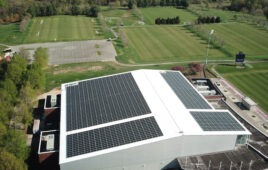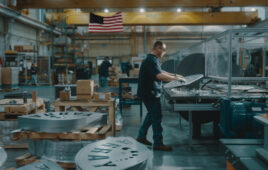The solar industry may have added 51,000 new solar jobs in 2016, but many of those jobs went unfilled. The Solar Foundation found that 84% of solar installers reported difficulty filling open installation positions in 2016.
“The overwhelming majority of employers are having difficulty hiring, and then a majority of those are saying it’s costing them—costing them money, costing them jobs. They’re turning down jobs because they just can’t find qualified workers,” said Tim Olson, who wrote The Solar Foundation’s 2017 Solar Training and Jobs Report, a report funded by a grant from the U.S. Department of Energy’s SunShot Initiative.
“Difficult hiring isn’t just unique to the solar industry,” Olson said. “You look at a lot of other skilled labor and general manufacturing positions in the U.S. and there is relatively high difficulty hiring right now—the unemployment rate is hitting all-time lows.”
But the solar industry is also very different from other types of skilled labor jobs—it’s a relatively new industry experiencing tremendous growth.
“When you add 25,000 positions in a year, that’s a lot of people you need to bring into a new industry,” Olson said.
Increasing exposure for young people
The solar industry won’t stop growing anytime soon, so one strategy to build the workforce is to introduce solar in public schools. A study by Generation 180, SEIA and The Solar Foundation found the cumulative solar capacity of U.S. K-12 schools grew 86% this year.
“My kindergartner son dreams about being a train engineer when he grows up because he is able to see trains around him and interact with them,” said Tish Tablan, national organizer for Generation 180, a nonprofit organization striving to advance the transition to clean energy. “If solar technology is visible and accessible throughout schools and communities in this country, more and more young people will be able to imagine themselves working in the solar industry.”
Tablan said adding solar to schools can have a ripple effect on the community. Students learn about it, then go home and tell their parents about it, and the message keeps spreading through the community to normalize the new technology.
Generation 180 encourages schools to put education center stage when they choose to install solar. She points to Charlottesville High School in Virginia, which has a flat screen TV monitor broadcasting the solar array’s performance when you first walk in to the school. Its interactive touchscreen display shows students the amount of energy they’re offsetting and how much greenhouse gas they’re bypassing with the solar array.
“That is the piece that helps make the solar energy real for students,” Tablan said.

Example dashboard graphics at Discovery Elementary School. The dashboard was created by VMDO Architects and CMTA Consulting Engineers.
Another standout school is Charlottesville-Albemarle Technical Education Center, which Tablan helped to secure a grant to get a 1-kW educational solar array on the roof. The school already had an electrician training course and, with the addition of the solar array, were able to add a solar installation course to its offerings.
“Having the solar technology on-site is enabling more schools to train specifically for a solar installation or a solar-specific career,” Tablan said.
Another technical school in Virginia has used an innovative partnership with a utility giant to add solar to its electrical course curriculum. Holly Jenkins, technical communications instructor for Chesterfield Career and Technical Center, applied for a grant from Dominion Energy to purchase the school a solar kit to outfit a small campus maintenance building.
“What Dominion liked about this grant is these students were going to be installing it and understanding the installation process of it,” Jenkins said.

A student explains the Chesterfield Career and Technical Center solar system to a representative from Dominion Energy and Superintendent of Chesterfield County Public Schools Dr. James Lane.
The school got the grant, and now students in the electrical training program monitor it as part of their course. At this point, there’s no dedicated solar program at the center, but Jenkins said the school tries to be on the cutting edge of skilled labor careers in the area. When teachers saw a demand in the market for precision machining workers, they added a precision machining training course. She said she could see the school adding a solar installation course in the future. In fact, she plans to invite local solar companies to the center’s spring job fair this year.
“I need to talk to them a little bit and kind of find out, ‘What’s the career path in your industry? What certifications do these young people need to earn? Or is it like, we’re going to bring you on board and we’re going to teach you what we need you to know?'” Jenkins asked.
Connecting trainers with installers
Olson said one big problem contributing to the labor shortage is many training institutions aren’t asking the kinds of questions Jenkins did. Many don’t communicate with installation companies enough, and vice versa.
“You talk to training providers, and they’re saying, ‘I’m training all these people or I have all these hungry job seekers who can’t find these jobs.’ So it’s really the disconnect that is costing the industry a lot of money and holding it back,” Olson said.
William Liuzza, owner of solar recruiting company EnergeiaWorks, agreed. EnergeiaWorks has a large talent pool, but many of the solar installer candidates have found work and are not looking to switch jobs. And the candidates who are available aren’t necessarily trained in solar specifically.
That means it takes EnergeiaWorks longer to find appropriately qualified and interested candidates, and takes the installers looking for the talent longer to fill open positions, which can delay delivery of solar projects.
“I think EPCs and developers need to start considering this factor,” Liuzza said.
Liuzza thinks some solutions to that problem could be more trade schools offering solar installation courses, and companies being willing to cross-train transferable skilled candidates in related energy fields or construction.
“As long as there is a demand for talent and the price of solar continues to fall, I don’t see this changing in the immediate future,” Liuzza said. “Even if the prices do level out, corporate sustainability alone can keep driving the industry.”
Olson said technical training programs need to talk to local solar installers to find out what they’re looking for in candidates.
“There’s this misperception out there that you need long training, you need a degree, you need some kind of certification to get into the solar industry, and that’s just all not true. Most employers have extremely low barriers to entry for decent-paying jobs with great promotion potential,” Olson said.
Olson said many community colleges and other solar training providers offer semester-long or multi-month-long training classes, when in reality solar installation companies told The Solar Foundation they don’t necessarily require that level of training. Olson said what they’re looking for is usually much more accessible—basic hands-on experience on a roof for 40 hours or less to make sure they’re familiar with how solar works, which could be achieved easily through volunteering with organizations like GRID Alternatives. The companies said they can take on additional training from there.
Tyler Anderson, president of Iowa Wind and Solar, echoed Olson’s point. He said his company looks for solar installation candidates with backgrounds in construction and the work ethic to show up on time and work hard. He said that’s been difficult to find.
“We’ve found that as long as we have one person that’s kind of the lead that’s really good, and they’re good at training, we can pull in pretty much anybody with construction experience and motivated to work and turn them into an installer,” Anderson said.
He said his company is working on restructuring because they’re having a hard time finding candidates who are experienced in multiple aspects of solar installation—from system design to electrical work and construction experience.
“I guess we’ll make it more specialized since we can’t find that well-rounded individual,” Anderson said.
As solar continues to grow, Anderson thinks institutions should offer more training in solar system design to better prepare candidates for careers at solar companies. And Iowa Wind and Solar plans to continue to do the bulk of the training for new employees with a good work ethic.
Collaborating to give students solar experience
Another solar company doing innovative work to bring in potential employees is Mountain View Solar (mtvSolar). Mike McKechnie’s company transitioned from homebuilding work to solar about a decade ago. A few years after McKechnie started the solar company, he was invited to sit on an advisory board at Hagerstown Community College in Maryland to help assemble an Alternative Energy Development course for the school. Then, McKechnie had the idea to work directly with the school and start an internship program for AED students during their summers off.
“We gave them an opportunity to work in an active, live solar company,” McKechnie said. “And it also gave us an opportunity to look at who the candidates were, try them out for the summer, and then look to who we might want to hire when they graduate either that year or the following year.”
Interns are involved in each step of the solar process, from sales, to permitting, to installation and answering any questions the solar customers may have after completion.
Mountain View has hired at least five employees from their internship program so far. But no love is lost for students who interned with the company and moved on.
“We’ve had plenty of people in that we’ve trained that have moved on, so we’re not necessarily the end spot, but we’re part of a diverse mechanism in training for people as they move on to other parts of the industry and other parts of the country,” McKechnie said.
McKechnie thinks more collaboration among solar companies and training institutions could greatly benefit the solar industry.
“I would say that we are stronger and more competitive than other companies based on our internship program that yielded high-quality employees,” McKechnie said.
Connecting the dots among the three crucial points in the pipeline—increasing awareness of solar job opportunities for job seekers, ensuring training institutions know what installers are looking for and maintaining installer willingness to offer on-the-job training—will help fill those open positions and make the solar industry grow even faster in years to come.







Tell Us What You Think!